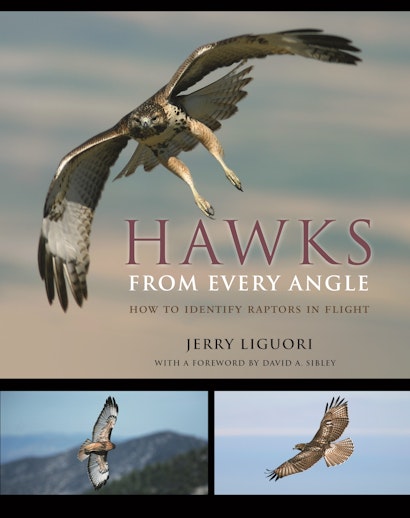Identifying hawks in flight is a tricky business. Across North America, tens of thousands of people gather every spring and fall at more than one thousand known hawk migration sites—from New Jersey’s Cape May to California’s Golden Gate. Yet, as many discover, a standard field guide, with its emphasis on plumage, is often of little help in identifying those raptors soaring, gliding, or flapping far, far away.
Hawks from Every Angle takes hawk identification to new heights. It offers a fresh approach that literally looks at the birds from every angle, compares and contrasts deceptively similar species, and provides the pictures (and words) needed for identification in the field. Jerry Liguori pinpoints innovative, field-tested identification traits for each species from the various angles that they are seen.
Featuring 339 striking color photos on 68 color plates and 32 black & white photos, Hawks from Every Angle is unique in presenting a host of meticulously crafted pictures for each of the 19 species it covers in detail—the species most common to migration sites throughout the United States and Canada. All aspects of raptor identification are discussed, including plumage, shape, and flight style traits.
For all birders who follow hawk migration and have found themselves wondering if the raptor in the sky matches the one in the guide, Hawks from Every Angle—distilling an expert’s years of experience for the first time into a comprehensive array of truly useful photos and other pointers for each species—is quite simply a must.
Key Features?
- The essential new approach to identifying hawks in flight
- Innovative, accurate, and field-tested identification traits for each species
- 339 color photos on 68 color plates, 32 black & white photos
- Compares and contrasts species easily confused with one another, and provides the pictures (and words) needed for identification in the field
- Covers in detail 19 species common to migration sites throughout the North America
- Discusses light conditions, how molt can alter the shape of a bird, aberrant plumages, and migration seasons and sites
- User-friendly format
"Hawks from Every Angle is a major advance in our knowledge of identifying raptors in flight and as such needs to be in the library (and field pack) of every serious raptor biologist, hawk watcher, and birder going afield in North America."—Donald S. Heintzelman, International Hawkwatcher
"Perhaps no one knows the intricacies of raptor identification better than Jerry Liguori. . . . There is no doubt that this book will advance the identification of raptors, and that every hawkwatcher will want to own this great new book."—Dan R. Kunkle, Wildlife Activist
"This book does a splendid job of educating its readers as to the specific characteristics the experts use to make their identifications. . . . [T]he book's strength is its numerous crisp diagnostic photographs that, if diligently studied, should make readers competent to correctly identify virtually any hawk species. This book is a fine example of the sophistication of field identification in the study of birds."—Choice
"I was a bit skeptical about the value of a photo guide, but Liguori, a raptor conservation biologist and excellent photographer, sweeps any doubts away. The book's 371 images, nearly all in color, of hawks from the front, side, below, and above, provide a new perspective on the 19 most common North American species. Read this handy guide and you'll never again have to say, 'All I know is it was a buteo.' This book definitely lives up to its title."—Val Cunningham, Birding Business News
"Hawks from Every Angle takes advantage of recent developments in digital photography and computer enhancement to offer a fresh approach to identifying raptors—as the titles promises—from every angle: head on, above, below, sideways, and from the rear...The guide's succinct but flowing text includes introductory material on light conditions, molt aberrant plumages, migration sites, weather, optics for hawk watching, and photography...As good as the text is, the guide's 339 color photographs are even better. Showing the birds as they actually appear in the field, the photos are its hear and soul."—Keith L. Bildstein, Birder's World
"Jerry Liguori has spent most of the last twenty years in the field watching and photographing hawks, and thousands of hours poring over photos and research to piece the puzzle of identification together. The result . . . is this guide, which is the most detailed and confident explanation yet of the myriad clues that lead to successful identification of hawks. This book is the first of its kind that deals with the real-world problems of identifying flying raptors from different angles. . . . The understanding of what hawkwatchers actually face in the field comes through on every page."—David A. Sibley, author of the National Audubon Society's The Sibley Guide to Birds
"There is nobody in North America whose identification skills and knowledge base concerning the flight identification of birds of prey surpasses Jerry Liguori. If you want to know where the high water mark in raptor identification falls today, it is in your hands. If you aspire to pin names to birds that fly just this side of the limit of conjecture with a high degree of confidence, start reading."—Pete Dunne, Vice President of Natural History Information, New Jersey Audubon Society, coauthor of Hawks in Flight
"We have all been perplexed and downright dumbfounded trying to identify flying raptors when seen at odd, but regularly viewed angles! Such difficult angles often offer only glimpses of identification markings shown in typical raptor field guides and bird guides. This impressive book, with its superb collection of color and black and white photographs and concise and informative data, tackles raptor identification problems that hawkwatchers face under real field conditions. Jerry Liguori has created a book that can easily be toted in the field, and is an absolute must-have for any raptor enthusiast!"—Brian K. Wheeler, author of Raptors of Eastern/Western North America, illustrator and coauthor of A Field Guide to Hawks of North America
"Jerry Liguori has long been one of our best raptor experts, and this stunning book proves it yet again. Depicting hawks in the real world, in the hawkwatching arena-and not in an idealized situation that rarely occurs-is this book's forte. Comparisons, contrasts, key points, and even potential pitfalls are highlighted in the excellent photos-and set the book apart. There are a number of raptor guides available, but we finally have one that shows hawks as they are truly seen in the field."—Clay Sutton, coauthor of Hawks in Flight and How to Spot Hawks and Eagles
"Hawks from Every Angle takes in-flight identification further than any previous book. Being a seasoned hawkwatcher, I can attest to the accuracy and usefulness of the material presented. Until now, much of the information herein has resided only in the heads of very experienced hawkwatchers and some of it, in the heads of only one or two very experienced hawkwatchers. Well organized and well written."—Tony Leukering, Rocky Mountain Bird Observatory
"Hawks from Every Angle will be quite useful to those seeking a better understanding of the field identification of raptors rather than a feather-by-feather description of plumages. Ultimately, birders want to know which species they are seeing, and this book will guide them to the correct identification."—Brian L. Sullivan, Cornell Lab of Ornithology


